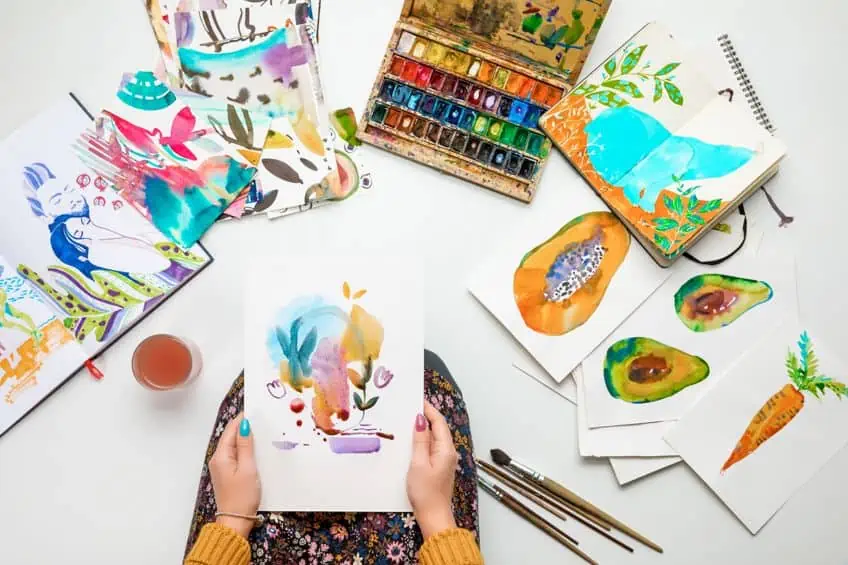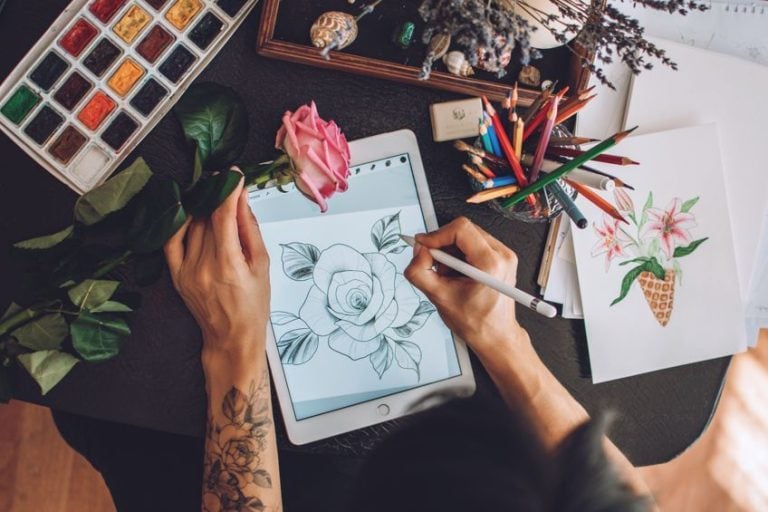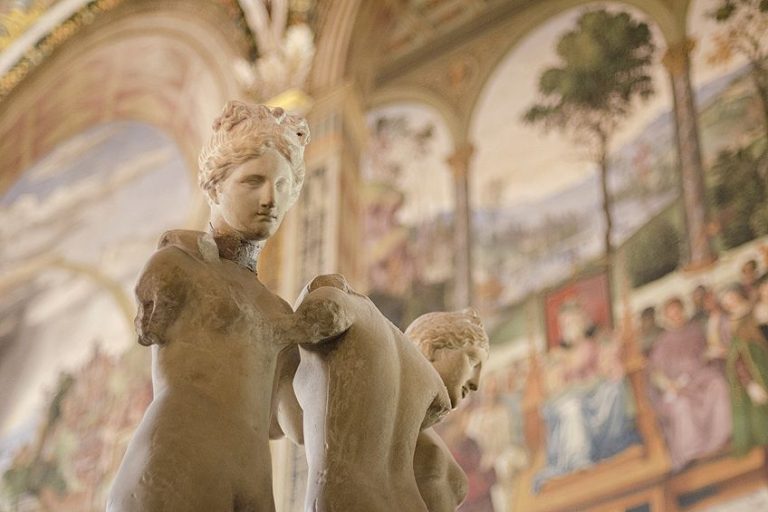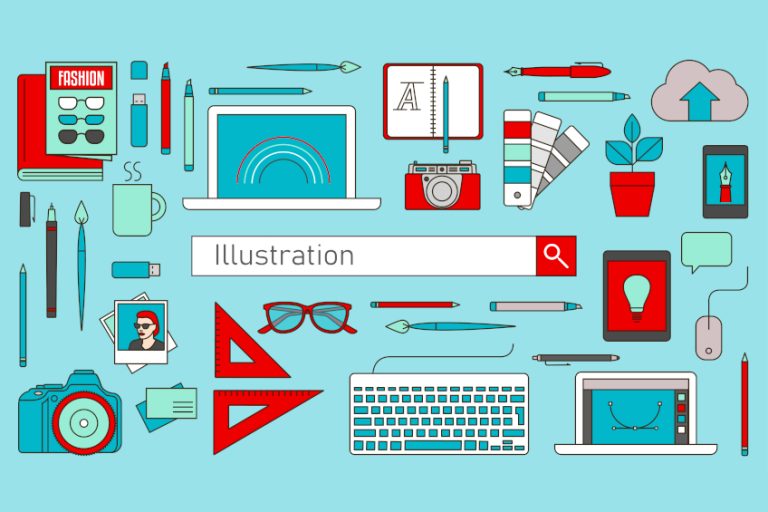How to Make an Art Portfolio – What to Put in an Art Portfolio
This post may contain affiliate links. We may earn a small commission from purchases made through them, at no additional cost to you.
If you are an artist, be it a designer, painter, or photographer, you need to showcase your work so that you can sell your art. Maybe you would like to study and apply to an art school? Creating an art portfolio is an important step for application. Whatever you decide, be it a physical hardcopy portfolio or an online version, you need to know what to put in an art portfolio.
Table of Contents
What Is an Art Portfolio?
An art portfolio can come in two main forms, you can physically make a portfolio to present, or you can create an online art portfolio. The physical art portfolio is usually needed most if you are applying to a learning institution, while if you are applying for a job, creating an art portfolio online might be a more effective option.

An art portfolio is something that helps you to showcase your work, and it should be something that also provides insight into your personality and interests, and professionally expresses your passion. The portfolio should be able to stand out among others and make an impression. If you are applying to an art school, a portfolio is a vital window revealing your abilities and objectives. When looking at what to put in an art portfolio, it should contain your best works.
An art portfolio can also be seen as a type of story and should show how you have grown and developed.
The internet has provided an entirely new way for artists to display their work. There are social media pages and portfolio websites that easily display an artist’s work. Many artists develop their own virtual galleries that can be open all day every day for the world to see. A professional personal portfolio website is a popular and ideal tool for any budding artist who is trying to sell their work and has fewer restrictions than some other available platforms. Having an online art portfolio has also become an expected part of an artist’s business.
How to Make an Art Portfolio
The main objective of an art portfolio is to show the work you can do, and as mentioned it can be used to apply at a college or to apply for a job, and it can be used to ultimately sell your artwork. Let us have a look at how to make an art portfolio in both cases.

Creating an Art Portfolio
If you are applying for college or other art institutions, make sure to look up what to put in an art portfolio as every place may have different requirements. Sometimes, it might require different formats, for example, if you apply to a graphic design or animation school, the portfolio they are looking for could be digital.
On the other hand, an art gallery might want actual drawings and sketches to look at.
Sometimes, you might only need about 10 to 20 of your best art pieces, and try not to include too many as not all of the pieces will be top quality. You should include enough pieces that show the range of what you can offer. Wherever you are applying, always check to see what they expect and stick to this, you do not want to have to redo something that does not have the correct format.
Making Your Selection
Again, find out the specifics of what the requirements are as some may want a selection of complete work, while others want to see the process you use when working. This helps to showcase your skills and provides a clearer picture of how you follow through with the creative process. A complete work of art is more than simply the final piece. When adding your artwork, make sure that you refine them, even the unfinished works. Remove any marks or smudges that you might still be on the art piece.

You might have to also include observational drawings, this will help to show how you observe form and shape, and how you determine proportion, perspective, and other details. As mentioned, you must only provide your best work, as you want to make sure you show your ability and quality of work. So, do not simply choose any piece to add variety, it is better to have only quality pieces, even if there is less variety.
Get an Unbiased Opinion
If you are unsure of what your best work is, ask a friend, or better yet someone who works in a similar field. Somebody who has experience in the same field or has gone through a similar process can help. Consider finding a mentor that is also an artist.
Learn to appreciate constructive criticism, so that you can improve on your work.
Select Original Art Pieces
You do not want to choose art pieces that are an imitation of another artist. Those viewing the portfolios usually see a lot of work and generally will be able to recognize any copied work. Doing this will reveal that you are lacking in creativity and your abilities are not up to standard. Also, when choosing pieces, do not let it be rushed, make sure you have enough time to reflect on your choices, and by doing so, you can ensure you select your best options.
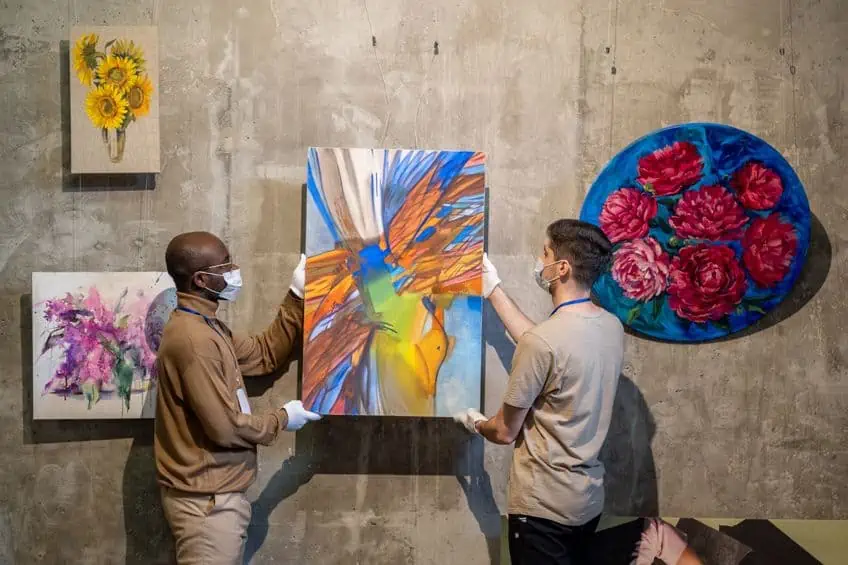
Include Awards or Publications
Besides your artwork, also include important publications or articles, and awards you may have received. This is a way to show that your work has been recognized and that you already have some exposure.
Bringing Everything Together
When putting the portfolio together, you might want to consider having a look at a few examples first. Find other popular and successful portfolios online and use these as a guide for your own portfolio. Do not copy the format, simply use it as a guide or reference, so that your own portfolio will still be original. Try to highlight your art pieces and not make the portfolio design itself more interesting. Remember, to always find out if there are any specific requirements in design or format.
Below are a few portfolio examples for inspiration.
- Michelle Carlos: She uses her own artwork to create a page background, showcasing her work. Appealing and easy to navigate, invites visitors to view more.
- Darren Hugh: This portfolio has a minimalistic and simple design that offers a balanced composition that is attractive and provides all the information needed.
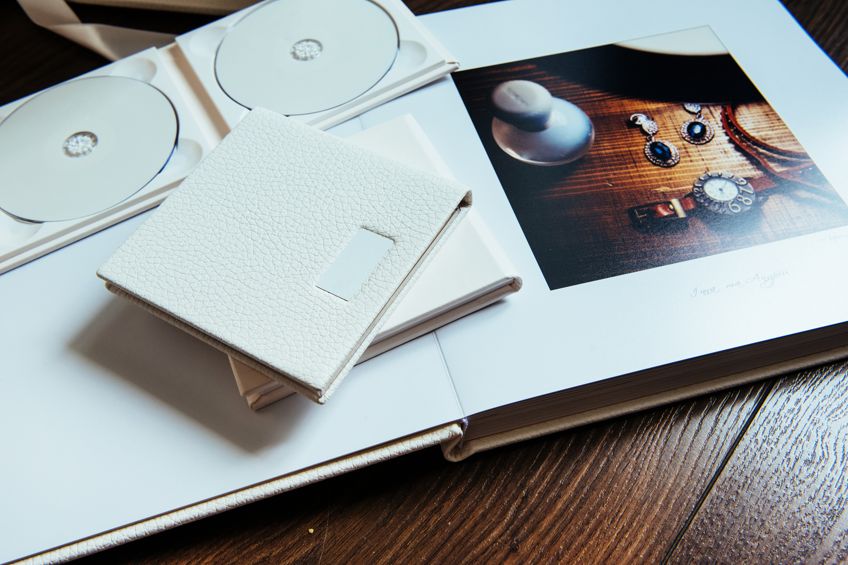
- June Digan: Here, you have a playful homepage illustration that also includes a short description of the artist and her work.
- Glory Samjolly: This website provides an eye-catching slideshow that shows off a selection of portraits.
- A few more inspiring examples include architecture and illustrations.
Consider arranging your portfolio in collections, for example, group by technique, subject, style, or media. This helps make it easier for any reviewer to locate information and helps them browse the portfolio with less effort. For example, group all pencil drawings or paintings together. You can also group by subject, for example, group landscape or figure drawings together. You could use a binder or try a scrapbook to place everything in.
Keeping It Simple
Maybe you have a few amazing ideas and are tempted to go a bit overboard on the portfolio. This is good, but remember to keep it professional, organized, and as simple as possible. You do not want to create a portfolio that is too busy, which will then distract from the actual art pieces.
Keep the information you provide within limits and try not to add too much on a single page.
You can still create a unique portfolio, without going overboard. Many industries are very competitive, so it is important your portfolio is unique and that your art pieces catch the eye. Do not obsess about the portfolio, once you have everything together, ask a mentor or someone you trust to provide feedback. Go over it a few times and make sure it is organized neatly and that there are no mistakes, and then try to leave it from there.
Adding an Online Art Portfolio
Making a hardcopy portfolio is important, but you can also do a virtual portfolio. Today, it is very likely that you will need to do this. You can photograph and scan your work onto a computer, using a good camera, or consider asking a professional as the images should be of high quality. Download the images and use a design program to create a portfolio you can easily edit. A virtual portfolio is also a great backup if you somehow lose the hard copy.
Online art portfolios are also ideal for selling artwork. Potential buyers and gallery owners get to see your work and purchase it. A virtual gallery of your artwork, again, should always contain your best work. You can also include some background about yourself as an artist, with an about page. All artists have a creative vision, make sure to bring this through in the online art portfolio design.
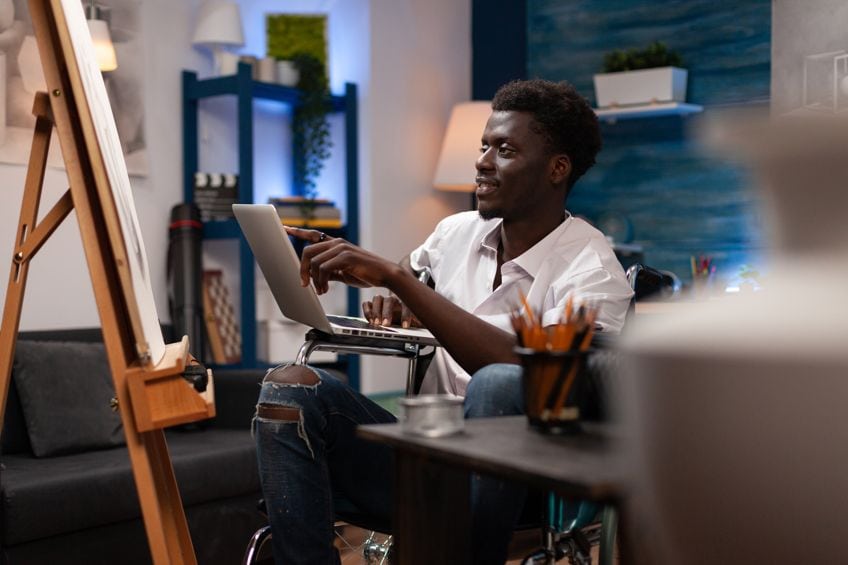
Check other similar websites, to check if yours meets all the criteria. Make use of your most outstanding art pieces and place them on the homepage or somewhere noticeable. These may help to entice visitors, who will then explore the website. Your pieces should aim for quality, more than quantity.
Keep it simple, do not add too many photos or descriptions or information that simply is too overwhelming. Keep it professional, elegant, and effortless to navigate. The images should be high resolution, and there are ways to compress file sizes so downloading does not take too long.
You should also be able to view the art pieces on any device, be it a laptop or mobile device, so the website builder you have, should have mobile responsive templates. To make your portfolio website visible online, it must be optimized. You should create good text captions, image descriptions, and other information that helps with the site rankings.
Adding a store to the website makes it easy to buy your work.
A lot revolves around social media, it is the easiest way to let visitors know about your projects and other announcements. Facebook as well as Instagram amongst other social media programs are usually easily integrated into a website. You should also consider including your CV and maybe a press page if you have any reviews of your artwork. Finally, creating a blog is a great way to also stay in contact with visitors, and allows visitors to get to know you more personally.
Presenting a Portfolio
To gain a bit more confidence, you can try and practice presenting your portfolio. You can practice alone or ask another person to help you. Preparing and knowing what you are going to talk about can aid in communicating more efficiently. For the most part, the art you present should speak for itself, you simply need to show the passion and meaning behind the artwork. Be prepared to make clear or answer any questions about your artwork.

Sometimes, representatives from a college will come to high schools on National Portfolio days. These representatives will review the student’s artworks and then provide feedback. So, students can then use this opportunity as a trial run before submitting a proper portfolio.
Updating Your Portfolio
Even after you have submitted portfolios, you should always update and revise if needed. You might have new work that is even better than your old work. This helps to keep what you are doing more relevant.
Also, you can add information you did not have before, for example, maybe you received an award, which you can now include in the portfolio.
Online Art Portfolio Websites
You can create your own website by using various platforms and website builders. However, there are also website portfolio sites, where artists are able to exhibit their work. These websites also provide many other features that can help with presenting your best works. See a few examples below.
- net: Sign up for free, which is great for beginners who can gain followers through the platform. You also get the Behance Pro Adobe Portfolio.
- Wix: Here, you can create, design as well as manage your portfolio website. You can start for free or there is a premium option.

- JournoPortfolio: Create an online portfolio with writers, photographers, designers, and artists in mind.
- Fabrik: You can build a beautiful portfolio using Fabrik, which helps support and celebrate all artists.
- Deviantart: Upload your art and create a portfolio on a community-based platform.
- Format: Showcase your artwork for others to see, and you can begin with a free trial.
An art portfolio is a way to showcase your work, whether you are applying for a job or want to enter an art school. You will need to show that you are an accomplished and technically capable artist. Take your time to compile your work, get an outside opinion and then go out there and present your work and abilities.
Frequently Asked Questions
What Is an Art Portfolio?
An art portfolio is a collection of work that helps to showcase what the artist can do, by providing samples of their method and style. Artists can use an art portfolio to apply to an art school, or it can also be used to display an artist’s work to potential buyers. Artists can create a hard copy or make an online art portfolio.
What to Put in an Art Portfolio?
There are a few things that should go into an art portfolio. The main thing is samples of 10 to 20 complete pieces of artwork that are of the best quality. The portfolio can also contain samples of sketches in progress to show how the creative process works, and it can cover a range of techniques, mediums, and subject matter.
Is There a Specific Order to a Portfolio?
You should try to group pieces that are similar, for example, pencil drawings or charcoal drawings. You can consider starting with your best piece that highlights your abilities and then place the rest, so it flows and tells a story. The portfolio should not be too complicated or contain too much information.
In 2005, Charlene completed her wellness degrees in therapeutic aromatherapy and reflexology at the International School of Reflexology and Meridian Therapy. She worked for a company offering corporate wellness programs for several years before opening her own therapy practice. In 2015, she was asked by a digital marketer friend to join her company as a content creator, and it was here that she discovered her enthusiasm for writing. Since entering the world of content creation, she has gained a lot of experience over the years writing about various topics such as beauty, health, wellness, travel, crafting, and much more. Due to various circumstances, she had to give up her therapy practice and now works as a freelance writer. Since she is a very creative person and as a balance to writing likes to be active in various areas of art and crafts, the activity at acrylgiessen.com is perfect for her to contribute their knowledge and experience in various creative topics.
Learn more about Charlene Lewis and about us.
